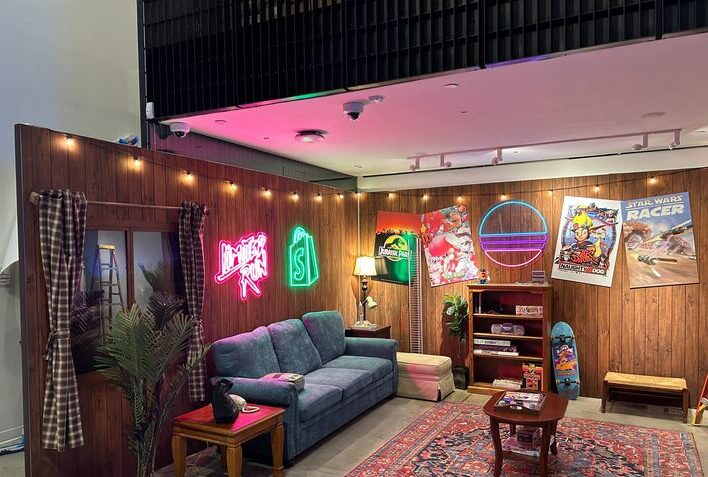If you’ve ever watched Emily in Paris, you know that the key to standing out in a crowded market is all about creating experiences people won’t forget. Emily, with her over-the-top ideas, often uses eye-catching events and immersive experiences to get people talking — whether it’s a fashion show in a hotel lobby or a wild influencer campaign. While Emily’s tactics might be just a tad “extra,” they ultimately work because at the end of the day, her ideas resonate with people and leave lasting impressions, and that’s exactly what experiential marketing is all about—creating emotional connections and unforgettable moments that stick with your audience.
And while we may not be planning a rooftop dinner party in Paris (unless you are looking for someone to plan the greatest rooftop dinner party, then, yes the answer is we’re available), businesses across various industries can absolutely leverage this approach to engage customers in ways that go beyond traditional advertising.
Because we want you to take full advantage of how truly wonderful experiential marketing can be, and not miss out on everything it can do for you and your business, we’ve listed our top ten ideal businesses that can benefit the most from experiential marketing with examples. Take a look:
1. Retail and Consumer Goods
Why It Works: Retail businesses thrive on customer interaction, and experiential marketing offers the perfect opportunity to create memorable in-store or pop-up experiences. Engaging customers through sensory-rich experiences, such as testing products or engaging in live demos, can drive foot traffic, increase brand loyalty, and enhance the overall shopping experience.
Examples: A pop-up shop where customers can experience virtual try-ons (clothing, shoes, glasses) or test beauty products with personalized consultations. Think in-store events featuring limited-edition product launches, or exclusive sneak peeks where attendees can see and experience precuts before they hit the shelves. People want to feel cared for and invited in, give the people what they want!
2. Technology and Consumer Electronics
Why It Works: Technology brands have a unique opportunity to showcase the power and functionality of their products through immersive demos and interactive experiences. As consumers often have to see and feel the product to understand its value, experiential marketing offers a chance to demonstrate complex technologies in a tangible way.
Examples: Hosting live product demos, virtual reality experiences, or interactive showcases of the latest gadgets. A brand like Meta (formerly Oculus) could host VR zones where users can experience cutting-edge games or virtual worlds firsthand. Tesla could allow consumers to test-drive their cars in an immersive, branded event space.
3. Automotive Industry
Why It Works: The automotive industry thrives on experiential marketing because cars are big-ticket items, and consumers typically want to experience them firsthand before making a purchase. Test drives, immersive events, and brand activations at major events (e.g., auto shows) can be highly impactful.
Examples: Test-drive events where potential customers can experience the vehicle’s features in different environments (urban, off-road, etc.). Creating interactive experiences like virtual reality test drives or custom car design stations. Luxury brands may host exclusive events where customers can test cars in exotic or special locations, making the experience feel aspirational. Please if your exotic location includes sunshine and warm weather, sign us up.
4. Food and Beverage (F&B)
Why It Works: The F&B sector can benefit immensely from experiential marketing by offering tastings, cooking demos, and interactive food experiences. Since food and drink are inherently sensory, creating a memorable experience around them can drive both immediate sales and long-term brand loyalty.
Examples: Creating food pop-ups where customers can sample new flavors or cooking techniques (e.g., gourmet food trucks or tasting events). An ice cream brand could create a customized sundae bar where customers mix and match flavors and toppings. Virtual cooking classes or exclusive tasting events featuring celebrity chefs could also be on the menu, letting your customers feel like they’re one step away from becoming the next Top Chef… or at least mastering the art of nurturing a sourdough starter that’s somehow more high-maintenance than your houseplant. If you happen to figure that one out, please let us know.
5. Travel and Tourism
Why It Works: The travel industry is all about creating dreams and fantasies, and experiential marketing can transport consumers to those dream destinations, even if only for a few moments. By creating immersive travel experiences or offering exclusive glimpses of new destinations, tourism brands can inspire wanderlust and deepen customer engagement.
Examples: Offering immersive cultural experiences at travel fairs or in-store activations, where visitors can sample a destination’s cuisine, music, and culture — it’s like travel, minus the baggage fees, but with all the wanderlust. Creating virtual reality travel experiences or “pop-up destinations” that offer customers a taste of a dream vacation (e.g., a VR simulation of a beach resort or a cruise ship). Then they take off the headset, and reality hits: they’re not actually sunbathing on the beautiful Italian coast — but hey, the idea’s planted, and now they NEED to plan that vacation. . .
6. Fashion and Beauty
Why It Works: Fashion and beauty brands are inherently well-suited for experiential marketing since their products are often about self-expression, style, and personal transformation. Pop-up shops, live runway shows, and interactive beauty consultations can create strong emotional connections with customers.
Examples: Hosting makeup tutorials, skin analysis stations, or live fashion shows — offering customers the opportunity to learn directly from experts. A beauty brand like Sephora could set up an interactive beauty bar where consumers try on different products using AR mirrors, or experience new skincare lines through hands-on samples and consultations. To elevate the experience even further, hosting Q&A sessions with well-known makeup artists or influencers could provide valuable tips and personal insights, creating an intimate atmosphere where attendees can ask questions, learn pro techniques, and feel like they’re part of an exclusive beauty community.
7. Entertainment and Events (Music, Sports, Festivals)
Why It Works: Entertainment and event companies are natural beneficiaries of experiential marketing, as they already deal with high-energy, immersive experiences. Experiential marketing can deepen the emotional connection fans have with a brand or event by engaging them in unique, participatory ways.
Examples: A pop-up museum or immersive film experience where fans can step into their favorite movie scenes. Hosting interactive sports events, where consumers can try out a sport or meet athletes. Fan zones at major events or festivals where attendees can participate in games, win merchandise, or access behind-the-scenes content. Getting invited to experience movies and music before their release adds a sense of inclusivity and insider access, which can lead to securing loyal customers.
8. Health and Wellness
Why It Works: The health and wellness sector has the opportunity to engage customers in transformative ways, whether through fitness challenges, wellness retreats, or health-focused product trials. By offering hands-on experiences that demonstrate the product or service’s benefits, brands can create lasting emotional connections.
Examples: A fitness pop-up where customers can take part in live workouts or mindfulness sessions, or a wellness brand could host a spa day experience with product samples. Offering personalized health assessments or wellness challenges (e.g., meditation or yoga events), and allowing customers to track their progress via an app.
9. Real Estate and Home Design
Why It Works: The real estate and home design industries are perfectly suited for experiential marketing, as buying a home or redesigning a space is a highly emotional and personal decision. Interactive tours, AR/VR home tours, or interactive design demos can offer an immersive look into how a space could transform.
Examples: A virtual reality tour of a new property development or a home design pop-up where customers can envision their dream home with interactive mood boards, furniture setups, and augmented reality design tools. Hosting open houses with immersive decor or providing personalized design consultations in temporary pop-up showrooms.Additionally, hosting exclusive parties, launch events, or influencer gatherings to generate buzz and get the word out, creating excitement and engagement around the brand or property.
10. Financial Services and Insurance
Why It Works: Though somewhat less obvious, financial services and insurance companies can greatly benefit from experiential marketing by creating trust and emotional connections with customers, two key elements in financial decision-making. Through educational pop-up events or digital experiences, these businesses can make complex financial products more relatable and accessible.
Examples: Hosting interactive financial literacy workshops, where participants can learn about budgeting, investing, or insurance in a fun, hands-on way. Offering personalized consultations on financial planning or retirement planning in immersive, branded environments. These initiatives allow customers to engage with complex financial topics in an accessible, supportive, and personalized manner. Together, these approaches foster stronger emotional connections, position your brand as a reliable, knowledgeable partner, and ensure that clients feel both supported and confident in their financial journey.
Wrapping It Up…
As we look ahead to 2025, it’s clear that the brands who truly embrace this approach—who prioritize engagement over advertising, who focus on emotional connection over sales pitches—will be the ones that stand out and thrive. So go ahead, get creative, and think outside the box. Because in the world of experiential marketing, the more memorable the experience, the greater the return. And hey, if all else fails, a rooftop dinner party in Paris might just be the perfect touch to close the deal.

